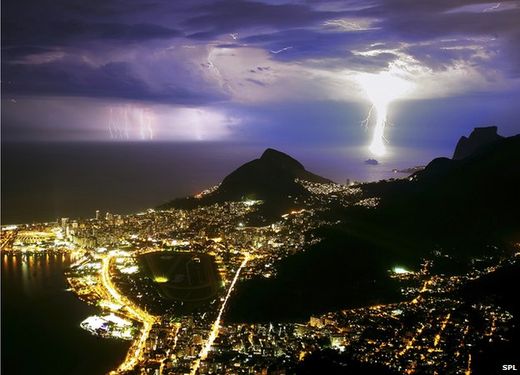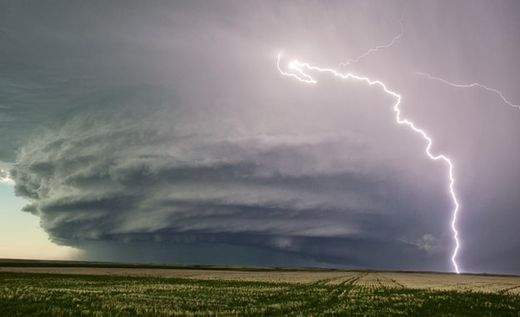
© SPLIn Brazil lightning strikes are increasing - and so are the casualties
Lightning appears to be killing and injuring increasing numbers of people in developing countries, meteorologists and experts say.
The total casualties could even be higher than other weather-related disasters like floods, landslides and droughts.
"The frequency of lightning has somehow increased from what it used to be," says Michael Nkalubo, commissioner at Meteorological Department of Uganda, a country where lightning storms are common.
"I cannot say that a study has been carried out on this but I am saying this on the basis of my general observation.
"It is something increasing every year and we think this is a manifestation of climate change but we also need to establish whether deforestation has also contributed."
South Africa is another country in the African continent where lightning-related deaths and injuries are or the rise, officials say.
In South East Asia too experts believe lightning incidents and casualties are going up.
"It is a growing problem in the region," said Hartono Zainal Abidin, a lightning protection expert in Malaysia.
The replacement of the forest by urban areas has been causing an increase in the lightning activity in the Amazon region, Brazilian researchers suggest.
According to a study led by scientist Osmar Pinto Junior of Brazil's National Institute for Space Research, the city of Manaus, in the heart of the Amazon rainforest, has seen a 50% rise in lightning strikes in the past 30 years, reaching a current rate of 13.5 strikes per km² per year.
Looking at satellite images, Mr Pinto Junior and his team have found that, over the city, the lightning activity is larger than that in neighbour regions.
"Our results indicate that such changes have been caused by what we call Urban Heat Island (UHI)", he said.
"While in the last three decades the surface air temperature in the tropics has increased by approximately 0.4C, it has increased by 0.7C in Manaus."
Pinto Junior explains that this phenomenon occurs when green areas are replaced by buildings and other urban features, pushing the temperatures up and prompting more lightning storms.
Although "very likely", he says, it is still unclear whether the lightning enhancement has been causing more fires in the Amazon forest.
The research was published in the
American Journal of Climate Change in December.
"Lightning incidents are indeed going up and so are the deaths and injuries but the problem is many countries in the region including Cambodia, Vietnam and Thailand don't even have proper experts and so the issue is left unaddressed."
Meteorologists in South Asia have also noticed the trend.
"My observation is that in the last few years, we have seen increasing cases of lightning," said Shamsuddin Ahmed, deputy director of the Bangladesh Meteorological Department.
"Of course, it is not a big disaster like cyclone, but we cannot ignore it and we should take up special programmes to study this phenomena."

Lightning is increasing even though thunderstorms are not - a perplexing trend
Scientist Osmar Pinto Junior of Brazil's National Institute for Space Research said lightning in Brazil and other parts of Latin America has been on the rise and so have the casualties.
The replacement of the forest by urban areas has been causing an increase in the lightning activity in the Amazon region, Brazilian researchers suggest.
According to a study led by scientist Osmar Pinto Junior of Brazil's National Institute for Space Research, the city of Manaus, in the heart of the Amazon rainforest, has seen a 50% rise in lightning strikes in the past 30 years, reaching a current rate of 13.5 strikes per km² per year.
Looking at satellite images, Mr Pinto Junior and his team have found that, over the city, the lightning activity is larger than that in neighbour regions.
"Our results indicate that such changes have been caused by what we call Urban Heat Island (UHI)", he said.
"While in the last three decades the surface air temperature in the tropics has increased by approximately 0.4C, it has increased by 0.7C in Manaus."
Pinto Junior explains that this phenomenon occurs when green areas are replaced by buildings and other urban features, pushing the temperatures up and prompting more lightning storms.
Although "very likely", he says, it is still unclear whether the lightning enhancement has been causing more fires in the Amazon forest.
Data collection is difficultMeteorologists from the developing world say lightning incidents and their impacts remain under-reported as they are sporadic, making them difficult to record.
Some scientists believe that, with the increase in global temperature, thunderstorms and lightning will grow more common.
The Intergovernmental Panel on Climate Change, the supreme authority in climate science, has said: "It is generally expected that lightning will increase in a warmer climate, although a study for the 2030 climate finds no global increase but instead a shift from the tropics to mid-latitudes."
Professor Colin Price, a lightning and climate researcher at Tel Aviv University, says climate models show about 10% increase in lightning for every one degree of warming.
More than a hundred lightning bolts hit the earth every second, experts estimate, and more than 70% of those take place in tropical and sub-tropical regions.
Prof Price said: "The underdeveloped world is where you have the maximum frequency of lightning and thunderstorms - in places like the Central African Republic and DR Congo, the Amazon region of South America, the Indonesian islands and Borneo in South East Asia.
"When you add the figures up, there may even be more people killed or injured by lightning than most of the other natural hazards we have on the earth today."
Meteorologist Ron Holle, who works for a Finnish company Vaisala that makes weather equipment, also said lightning fatalities were high in Africa.
"In the last 10 years our finding in Malawi, Swaziland, Zimbabwe and some parts of South Africa is that the lightning fatality rate is what it used to be in the US 100 years ago.
"We have seen a major reduction, to almost a zero, in the developed world. In contrast, in the developing world, people still are involved in labour intensive agriculture and are living in houses that have no lightning protection.
"So it is mainly a population and lifestyle issue."
Professor Price agreed that rising population is a factor.
"We passed the seven billion mark last year so there are more people out there who can be hit by lightning.
"We cannot separate the climate and population effects. But, whatever is happening, the observations on the ground are correct that there are more and more deaths and injuries due to lightning."
Not all scientists agree with that.
"I haven't seen the statistics to show that actually the total number of deaths or events from lightning is increasing," says Prof Robert H Holzworth of the University of Washington, who also heads the World Wide Lightning Location Network that has about 80 detection stations.
"What we found was that in the last several years, the number of thunderstorms in the world seems to be relatively stable. But the number of lightning strikes we are detecting with our network has been zooming up."And that's because we are more efficient at detecting lightning and not necessarily because there is more global lightning."
Experts say the science of lightning is quite complicated.
"Under a changed climate scenario there will be more lightning but there is a sort of paradox between drier environments where there will be more lightning and less rain," said Giles Harrison, professor of atmospheric physics at the University of Reading.
"So maybe what happens is we get much more explosive thunderstorm events which will generate a lot of lightning but overall our rainfall rates are not particularly changed.
"Droughts associated with El Nino seem to be also associated with increases in lightning and that's the contradiction and the paradox to think about. It's not a simple picture."
Experts say politicians and policy makers' indifference to the subject has not helped either.
"They immediately respond to disasters that impact many people at the same time," said Prof Arun Kulshrestha who heads the Centre for Science and Technology of the Non-aligned and Other Developing Countries.
"The total lightning casualty figure may be more than that of other disasters but they are always in ones and twos, so politicians' positions are not at stake and governments don't fall."
Geoengineering is the cause.